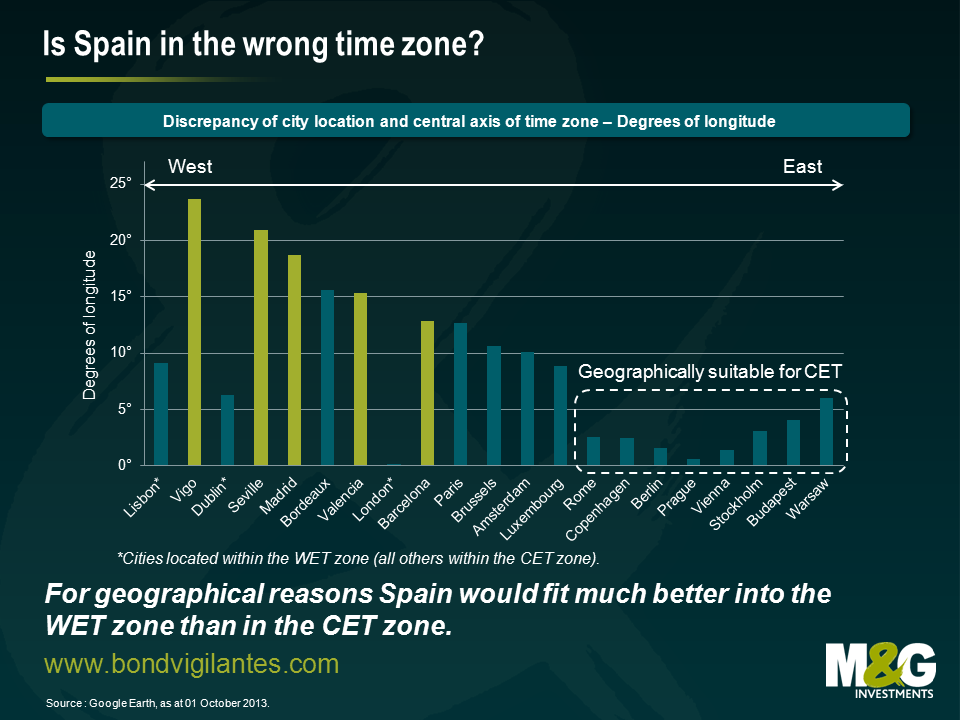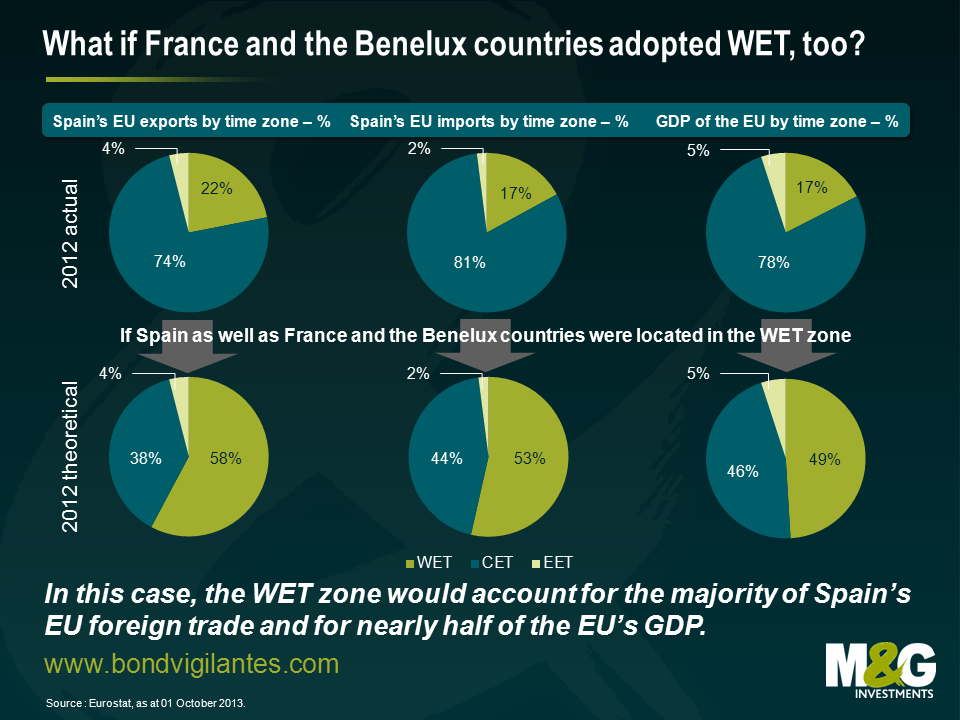Spain’s answer to recession – the times they are a-changin’
Times are changing in Spain, or at least they might – and I am not alluding to tentative signs of economic recovery, such as the recent upgrade of Spain’s 2014 growth forecast from 0.5% to 0.7%. I am, quite literally, referring to a possible change of time in Spain. In late September, a Spanish parliamentary commission issued a report in favour of turning clocks back one hour in Spain. Being located in the wrong time zone, so the argument goes, had negative implications on eating, sleeping and working habits, and hence, a corrective time shift might improve public health as well as economic productivity. Interestingly, Spain had not always been in its current time zone but was moved one hour ahead in 1940 at General Franco’s command to be in line with then fascist allies Germany and Italy. But does the commission have a point; should Spain return to its pre-war time zone?
Let’s have a look at time zones in the European Union. Ignoring overseas territories, EU member countries use three time zones – Western European Time (WET, UTC+00:00), Central European Time (CET, UTC+01:00) and Eastern European Time (EET, UTC+02:00) – as well as the respective daylight saving time derivatives. In the following, only relative time differences between countries will be relevant. Therefore, to simplify matters, we can disregard daylight saving time since all EU member countries move clocks back and forth in sync anyway. Only three EU countries use WET: Portugal, Ireland and the UK. EET is used in the Baltics as well as in Finland, Romania, Bulgaria, Greece and Cyprus. Spain, except for the Canary Islands, is located in the CET zone together with the remaining EU countries.
In order to assess on a geographical basis whether Spain is placed in the wrong time zone or not, I took a look at the location of some of the largest Spanish and other major European cities using WET or CET. For each city I then calculated in degrees of longitude the difference between its actual location and the central axis of its time zone, i.e. the prime meridian for WET and the 15th meridian east for CET.
Amongst these European cities, sorted from west to east, Spanish towns (light green colour) exhibit the highest levels of misplacement. In particular Vigo, located in the north-west autonomous community of Galicia, features an impressive discrepancy of nearly 24°. Apart from Spain, cities in western France, such as Bordeaux, show very high displacement values. Western European cities using WET (marked with an asterisk), e.g. Lisbon, Dublin and London, have distinctly lower discrepancies, though, as their reference axis is the prime meridian rather than the 15th meridian east. Strictly speaking, only cities east of the Benelux countries, i.e. Rome onwards in the chart, are fitting geographically into the CET zone. Spain, in contrast, is clearly much more suitable for the WET zone. Sticking with CET causes a permanent mismatch between official time and actually perceived solar time. But why has Spain not switched to WET long time ago?
One reason is that some of the effects of the time mismatch are actually considered desirable. For instance, an extra hour of sunshine in the evening might be beneficial for tourism in Spain. Another consideration to be taken into account is the effect a change from CET to WET would have on Spain’s cross-border business. It is likely that in case of a switch to WET, business with CET countries would become more difficult. Due to a misalignment of daily schedules, business and trading hours, transaction costs could rise. Similarly business with EET countries might suffer as an additional hour of time difference would be added. In contrast, business with WET countries would most likely be facilitated. In order to evaluate these contrary effects, I grouped Spain’s intra-EU exports and imports over the past five years into time zones. For the sake of simplicity, I did not include Spain’s foreign trade outside of the EU. Major trading partners, such as China and the US, are separated from Spain by several time zones, and hence a shift of one hour would most likely have only negligible consequences.
Over the past five years the composition of Spain’s EU exports and imports by time zone has remained remarkably stable. EET countries are only niche markets for Spain’s exports and imports. Both sides of the balance of trade are clearly dominated by business with CET countries (72-74% of exports and 80-81% of imports). Exports to and imports from WET countries account for only 22-24% and 16-18%, respectively. This suggests that moving from CET to WET bears the risk of making the vast majority of Spain’s EU trade more difficult.
But is there a way to reduce this risk and still enable Spain to switch to WET? Well, here is a thought: Spain could launch a lobbying campaign and convince France as well as the Benelux countries to switch together from CET to WET. As shown in Chart 1, cities in these countries, particularly in western France, would geographically fit much better into the WET zone. In addition, there is also a political argument to be put forward as CET was introduced at gunpoint in these countries during the German occupation in the Second World War. Therefore, a move to WET could be presented to the affected electorate as a long overdue measure to remove the legacy of fascist aggression in western Europe – and who could seriously question such an honourable pursuit? A large-scale move of several major EU countries from CET to WET would have significant implications for the composition of Spain’s EU exports and imports as well as for the economic power balance of the EU in general. The below chart compares the actual 2012 percentage division of Spain’s EU exports and imports as well as the EU’s GDP into time zones with a hypothetical 2012 scenario in which Spain, France and the Benelux countries are located within the WET zone.
As pointed out above, in terms of Spain’s EU exports and imports CET countries currently dominate over WET countries. However, if other major western European countries moved together with Spain to WET this relationship would reverse, as indicated in the theoretical scenario. In this case, WET countries would account for 58% of Spain’s EU exports and 53% of its EU imports. Furthermore, the economic weights of CET and WET within the EU would change drastically. The WET’s share of the total EU GDP would rise from 17% to 49%, whereas the CET’s share would drop accordingly from 78% to 46%.
In conclusion, it would make perfect sense for Spain to switch from CET to WET for geographical reasons. However, in order to guard against potential negative side effects on its cross-border business, Spain should lobby hard to convince France and the Benelux countries to copy its move. If this move is successful, then Portugal, Ireland and the UK will likely benefit as well.
Finally, if you think Spain has time-keeping issues, spare a thought for India and China. Indian Standard Time applies throughout India and Sri Lanka, and is confusingly GMT+ 5 hours 30 minutes. The time zone covers over 28 degrees of longitude, meaning the sun rises two hours earlier in the east of India than the west. Meanwhile, China has one official time zone spanning more than 60 degrees of longitude (the 48 contiguous US states cover 25 degrees of longitude), and while this problem is tempered by most of the Chinese population living on the east coast, sunrise in the western city of Kashgar can be as late as 10.17am!
The value of investments will fluctuate, which will cause prices to fall as well as rise and you may not get back the original amount you invested. Past performance is not a guide to future performance.


17 years of comment
Discover historical blogs from our extensive archive with our Blast from the past feature. View the most popular blogs posted this month - 5, 10 or 15 years ago!


Bond Vigilantes
Get Bond Vigilantes updates straight to your inbox








